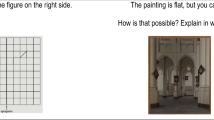Abstract
This study attempts to explain certain difficulties which ninth grade students face in tackling geometrical “problems to prove”, by relating them to general and to specific rigidity and cognitive style variables. The specific Geometrical Rigidity (GR) construct was conceived as comprising a perceptual component named Geometrical Functional Fixedness (GFF) and a conceptual component named Geometrical Method Embeddedness (GME). The general rigidity constructs were SDI and BRT that were derived within the Field Theory of K. Lewin and the Gestalt Theory respectively. The cognitive style construct was articulated-global style (measured by EFT). The results show that (a) GFF and GME are mutually independent (b) GR and its components have small negative correlations with SDI (c) GR and its components have insignificant correlations with BRT (d) GR and its components have strong negative correlations with articulated-global style (e) school geometry achievement has strong negative correlations with GR and its components, positive correlations with SDI and EFT, and insignificant correlations with BRT (f) GR is a potent and efficient predictor of future failure in school geometry learning. These results confirm the conceptual analysis of GR and indicate that GR has an independent existence as a cognitive style construct rather than a personality trait.
Similar content being viewed by others
References
BirchH. G. and RabinowitzH. S.: 1951, ‘The negative effect of previous experience on productive thinking’ J. of Experimental Psychology 41, 121–125.
BloomB. S. (ed.): 1956, Taxonomy of Educational Objectives, Longmans, London.
BourneL. E., ExtrandB. R. and DominowskiR.L.: 1971, The Psychology of Thinking, Prentice-Hall, Englewood Cliffs.
BraenB. B.: 1960, ‘Development of theoretically-based manifest rigidity inventory’, Psychological Reports, 6, 75–88.
BraenB. B. and WallenN. E.: 1960, ‘Measurement of rigidity in high school students’, Psychological Reports 7, 11–17.
BreskinS.: 1968, ‘Measurement of rigidity, a nonverbal test’, Perceptual and Motor Skills 27, 1203–1206.
BreskinS. and GormanB. S.: 1969, ‘On rigidity and field dependence’, Perceptual and Motor Skills 29, 541–542.
BusseT. V.: 1968, ‘Establishment of the flexibility thinking factor in fifth grade boys’, J. of Psychology 69, 93–100.
CampbellD. T. and StanleyJ. C.: 1966, Experimental and Quasi-Experimental Design for Research, Rand McNally, Chicago.
CattellR. B. and TinerL. G.: 1949, ‘The varieties of structural rigidity’, J. of Personality 17, 321–341.
ChownS. M.: 1959, ‘Rigidity—a flexible concept’, Psychological Bulletin 56, 195–223.
CowenE. L.: 1952, ‘The influence of varying degrees of psychological stress on problem solving rigidity’, J. of Abnormal and Social Psychology 47, 512–519.
Duncker, K.: 1945, ‘On problem solving’, Psychological Monographs 58, no. 5 (whole no. 270).
Fenchel, C. H.: 1958, Cognitive rigidity as a behavioral variable manifested in intellectual and perceptual tasks by an out patient population (Unpublished Ph.D. dissertation, New York University, New York).
Gardner, H., Holtzman, P. S., Klein, G. B., Linton, H. and Spence, D. P.: 1959, ‘Cognitive control: a study of individual consistencies in cognitive behavior’, Psychological Issues 1, no. 4 (whole no. 8).
GoodsteinL. D.: 1953, ‘Intellectual rigidity and social attitudes’, J. of Abnormal and Social Psychology 48, 345–353.
GuetzkowH.: 1951, ‘An analysis of the operation of set in problem solving behavior’, J. of General Psychology 45, 219–244.
Hoz, R.: 1976, The Effects of Training in Heuristic Strategies on Problem Solving Rigidity (Unpublished Ph.D. Dissertation, Hebrew University of Jerusalem).
HunterI. M. L.: 1956, ‘The influence of mental set on problem solving rigidity’, British J. of Psychology 47, 63–64.
JuolaJ. F. and HargenhahnB. R.: 1968, ‘Effects of training level, type of training and awareness on the establishment of mental set in anagram solution’, J. of Psychology 69, 155–159.
LeachP. J.: 1967, ‘A critical study of the literature concerning rigidity’, British J. of Social and Clinical Psychology 6, 11–22.
LevittE. E. and ZelenS. L.: 1953, ‘The validity of the Einstelling Test as a measure of rigidity’, J. of Abnormal and Social Psychology 48, 573–580.
Luchins, A. S.: 1942, ‘Mechanization in problem solving’, Psychological Monographs 54, no. 6 (whole no. 248).
MaierN. R. F. and BurkeR. J.: 1966, ‘Test of the concept “availability of functions” in problem solving’, Psychological Reports 10, 115–125.
NewellA. and SimonH. A.: 1972, Human Problem Solving, Prentice-Hall, Englewood Cliffs.
PolyaG.: 1957, How to Solve It, Anchor Books, New York.
PolyaG.: 1962, Mathematical Discovery, Vol. I, Wiley, New York.
RokeachM.: 1948, ‘Generalized mental rigidity as a factor in ethnocentrism’, J. of Abnormal and Social Psychology, 43, 259–278.
ScheererM. and HullingM. D.: 1960, ‘Cognitive embeddedness in problem solving: A theoretical and experimental analysis’, in KaplanB. and WapnerS. (eds.) Perspectives in Psychological Theory, International University Press, New York.
VernonP. E.: 1972, ‘The distinctiveness of field dependence’, J. of Personality, 40, 366–391.
WitkinH. A., DykR. B., FatersonH. F., GoodenoughD. R. and KarpS. A.: 1962, Psychological Differentiation, Wiley, New York.
WitkinH. A., MooreC. A., GoodenoughD. R. and CoxP. W.: 1977, ‘Field dependent and field independent cognitive styles and their educational implications’, Review of Educational Research 47, 1–64.
Zaks, M. S.: 1954, Perseveration of Set: A Determinant in Problem Solving Rigidity (Unpublished M.A. thesis, Roosevelt College of Chicago, Chicago).
Author information
Authors and Affiliations
Rights and permissions
About this article
Cite this article
Hoz, R. The effects of rigidity on school geometry learning. Educ Stud Math 12, 171–190 (1981). https://doi.org/10.1007/BF00305620
Issue Date:
DOI: https://doi.org/10.1007/BF00305620




